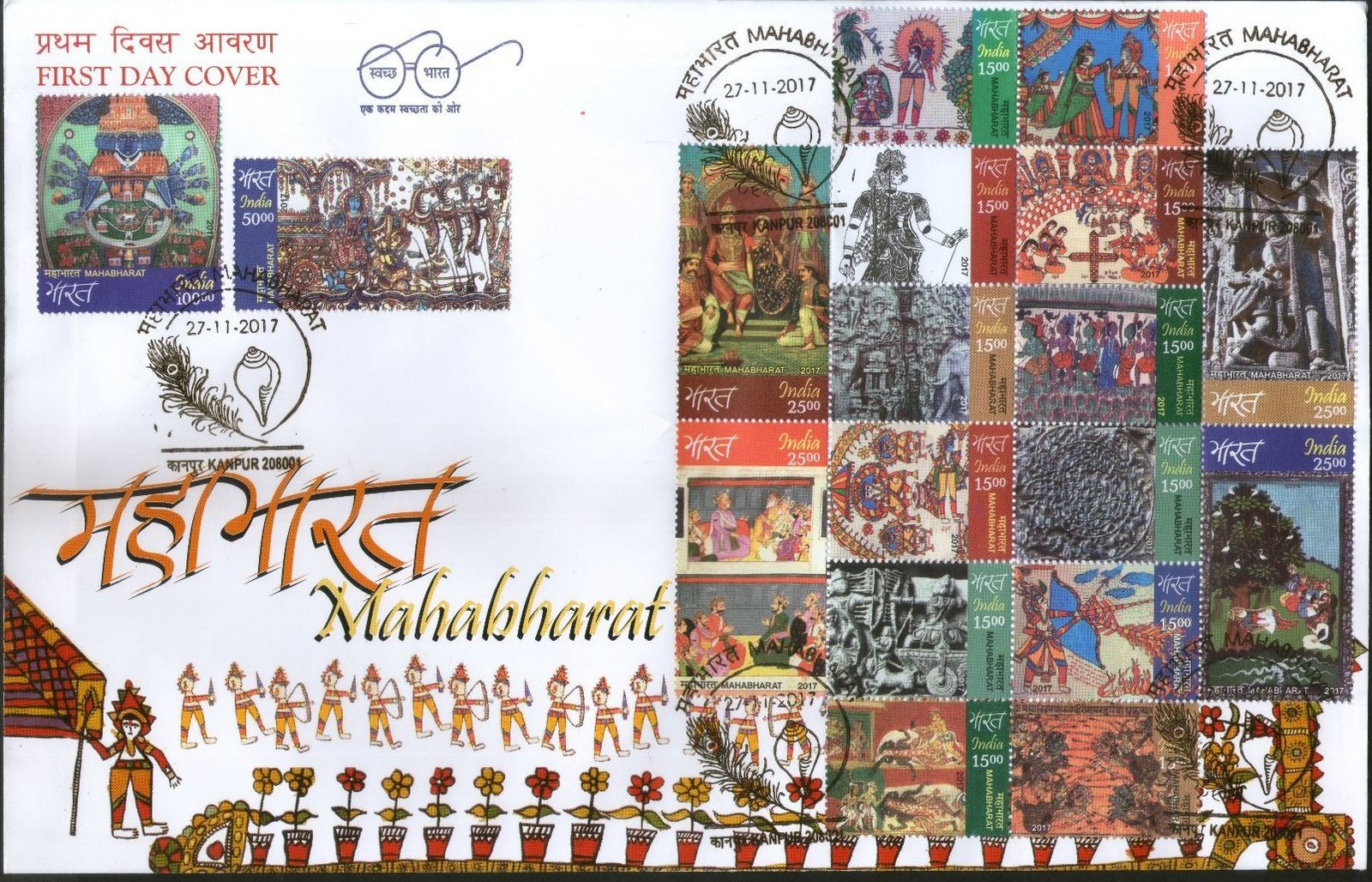The Mahabharat Epic Mini Sheet

Technical Data
| Date of Issue | November 27, 2017 |
|---|---|
| Denomination | Rs. 430 |
| Quantity | 500,000 |
| Perforation | 13 |
| Printer | Security Printing Press, Hyderabad |
| Printing Process | Wet Offset |
| Watermark | No Watermark |
| Colors | Multicolor |
| Credit (Designed By) | Ms. Anika Singh Ms. Meena Mani Ms. Nenu Gupta Sh. Bharati Mirchandani Shri. Lakshmikant Dash Smt. Santok Ba |
| Catalog Codes |
Michel IN 3262-3279KB Yvert et Tellier IN BF166 Stanley Gibbons IN MS3404 |
| Themes | Elephants | Literature | Religion |
Mahabharat – The Eternal Epic of India
A World Within Itself
The Mahabharat is a world of its own — vast, profound, and eternal. It encompasses every human emotion, every moral conflict, and every philosophical inquiry. Each character is unique, every relationship complex, and every event deeply symbolic. As F. Woods famously said, “What is not here, is nowhere else.”
Origins of the Great Epic
The Mahabharat, compiled by Sage Vyasa between 700 BCE and 300 CE, stands as one of the greatest Sanskrit epics of India. It belongs to the Puranic period and reflects the culmination of centuries of cultural, spiritual, and philosophical evolution. The Bhagavad Gita, a sacred dialogue between Lord Krishna and Arjuna, is set within this epic during the Bhisma Parva, moments before the great war begins.
Philosophical and Spiritual Depth
The Mahabharat integrates Vedic philosophy, Upanishadic wisdom, and Itihas-Puranic narratives, forming the very foundation of Indian thought. The Bhagavad Gita, revealed by Lord Krishna, illuminates the eternal principles of Dharma (righteous duty), Karma (action), and Yoga (spiritual discipline).
Through Krishna’s counsel, Arjuna overcomes his moral dilemma and understands that performing one’s duty with detachment is the true path of righteousness.
As scholar Nick Sutton notes, the Mahabharat dramatizes the ethical tension between moral and ritual duty, and the Gita provides a resolution to this spiritual conflict.
Themes of Fate, Power, and Humanity
The Mahabharat mirrors the cosmic struggle between good and evil, highlighting human frailty amidst divine guidance. It depicts violence, deceit, revenge, and redemption within both divine and mortal realms. Characters such as Duryodhana and Shakuni embody arrogance and deceit, while the Pandavas stand as symbols of righteousness and endurance.
The Strength of Draupadi
Among the epic’s most compelling figures is Draupadi — a woman of extraordinary dignity and determination. Her suffering, courage, and intelligence make her a symbol of female strength in Indian tradition. While she endured great humiliation, she also stood unflinchingly for justice and self-respect.
Key Episodes and Symbolism
The House of Lacquer (Lakshagriha)
Duryodhana’s hatred for the Pandavas leads to the construction of a lacquer house, a deadly trap meant to burn them alive. However, due to Vidura’s cryptic warning, the Pandavas escape through a secret tunnel — a triumph of wisdom over wickedness.
The Battle and Divine Weapons
In the climactic war, Karna, armed with a celestial weapon from Indra, kills Ghatotkach, the valiant son of Bheema and Hidimbi. His sacrifice saves Arjuna, showing the inevitability of fate and the cost of heroism.
Shikhandi and Bhisma
The story of Shikhandi and Bhisma underscores transformation, destiny, and moral complexity. Knowing Bhisma would never fight a woman, Arjuna uses Shikhandi as a shield, fulfilling divine destiny on the battlefield.
Beyond War – A Journey of Growth
Beyond its depiction of war, the Mahabharat is also a bildungsroman — a tale of growth and transformation. It traces the journey of the Pandavas and Kauravas from childhood to maturity, exploring human evolution through experience, learning, and destiny.
Cultural and Artistic Legacy
The Mahabharat transcends time and geography. It has inspired art, dance, theatre, music, literature, and philosophy not only in India but across the world. Every region of India preserves elements of the epic — in sculpture, folk painting, temple art, and oral traditions. Its influence echoes through every era, remaining a cornerstone of India’s cultural and spiritual identity.
Mahabharat in Philately – A Tribute through Stamps
Celebrating the Living Tradition
The Department of Posts has issued a magnificent set of 18 commemorative stamps and two miniature sheets to honour the vast legacy of the Mahabharat. These stamps portray scenes, episodes, and artistic interpretations of the epic from different regions and styles of Indian art.
Honouring Folk Artists
Several stamps and design motifs are adapted from the monumental scrolls painted by Sonika Ba, an unlettered folk artist from central India. Her 12,000-metre-long scroll, depicting the Mahabharat in its entirety, is preserved at the Indira Gandhi National Centre for the Arts (IGNCA), New Delhi. The Department of Posts proudly presents her work to the world, acknowledging her family and the many anonymous artists who have kept this tradition alive.
First Day Cover

